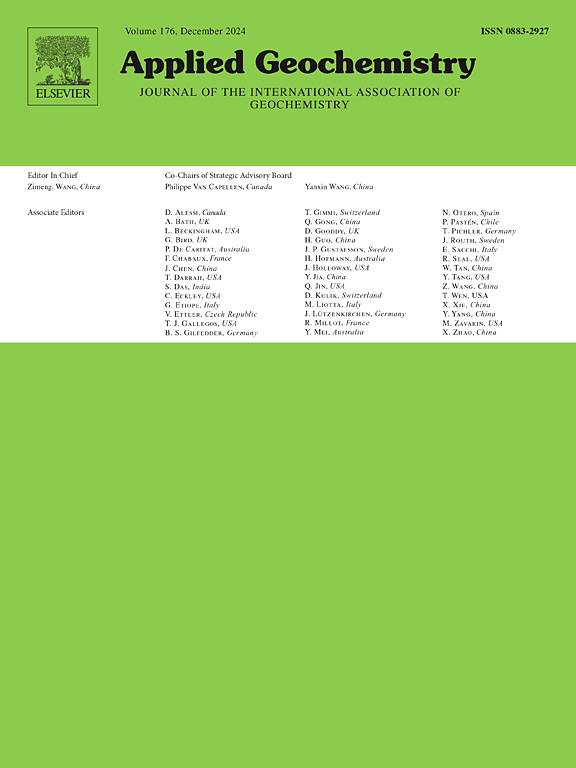Geochemistry of geothermal well gases from superhot zones of Larderello, Italy
IF 3.4
3区 地球科学
Q1 GEOCHEMISTRY & GEOPHYSICS
引用次数: 0
Abstract
At Larderello, granitic intrusions into a thinned continental crust act as the heat source for the regional thermal anomaly, and a major seismic reflector (K-horizon) extends all over the field at 3–6 km depth. The geological meaning of the K-horizon is still under debate, and some authors believe that the presence of high-P, supercritical fluids may explain this feature. In late 2017, a deep well was deepened at Larderello to search for supercritical fluids. Temperatures more than 500 °C were estimated at the bottom hole, associated with a leak-off pressure of about 30 MPa, though an exploitable reservoir was not proven. The lack of relevant fluid entries in concomitance with the crossing of the local major seismic reflectors, during the deepening of the well, raised fundamental questions about the geothermal significance of these seismic reflectors, as well as their relevance as possible targets for drilling and industrial exploitation of supercritical fluids.
To gain some insight into the super-hot horizons of the Larderello geothermal field, we present new geochemical data on gases from productive wells approaching the K-horizon, and/or closely related to granitic bodies in the southern and eastern sectors of the geothermal field. The wells considered here discharge a single gaseous phase, draining a vapor-dominated reservoir at temperatures up to 375 °C. The stable isotope signature of steam is indicative of enhanced water-rock interactions at depth (oxygen-shift), and the C–He isotope systematics allowed the identification of a predominant crustal source for CO2. The He isotope distribution at the surface mirrored a dynamic balance between crustal- and mantle-derived fluids, as also indicated by the relative abundances of N2, Ar, He, and Ne.
意大利Larderello超热区地热井气体地球化学研究
在Larderello,进入薄大陆地壳的花岗岩侵入物充当了区域热异常的热源,并且一个主要的地震反射面(k -层)在3-6 km深度延伸到整个油田。k层的地质意义仍在争论中,一些作者认为,高p、超临界流体的存在可以解释这一特征。2017年底,在Larderello加深了一口深井,以寻找超临界流体。井底温度估计超过500°C,泄漏压力约为30 MPa,但尚未证实存在可开采的储层。在井深过程中,由于缺少与当地主要地震反射面相交的相关流体入口,因此对这些地震反射面的地热意义以及它们作为超临界流体钻井和工业开发可能目标的相关性提出了根本性的问题。为了进一步了解Larderello地热田的超热层,我们提供了接近k层的生产井和/或与地热田南部和东部花岗岩体密切相关的气体的新的地球化学数据。这里考虑的井只排出一种气态,在高达375°C的温度下排出气控油藏。水蒸气的稳定同位素特征表明深层水-岩相互作用增强(氧移),C-He同位素系统允许确定CO2的主要地壳来源。地表He同位素分布反映了地壳和地幔流体之间的动态平衡,N2、Ar、He和Ne的相对丰度也反映了这一点。
本文章由计算机程序翻译,如有差异,请以英文原文为准。
求助全文
约1分钟内获得全文
求助全文
来源期刊

Applied Geochemistry
地学-地球化学与地球物理
CiteScore
6.10
自引率
8.80%
发文量
272
审稿时长
65 days
期刊介绍:
Applied Geochemistry is an international journal devoted to publication of original research papers, rapid research communications and selected review papers in geochemistry and urban geochemistry which have some practical application to an aspect of human endeavour, such as the preservation of the environment, health, waste disposal and the search for resources. Papers on applications of inorganic, organic and isotope geochemistry and geochemical processes are therefore welcome provided they meet the main criterion. Spatial and temporal monitoring case studies are only of interest to our international readership if they present new ideas of broad application.
Topics covered include: (1) Environmental geochemistry (including natural and anthropogenic aspects, and protection and remediation strategies); (2) Hydrogeochemistry (surface and groundwater); (3) Medical (urban) geochemistry; (4) The search for energy resources (in particular unconventional oil and gas or emerging metal resources); (5) Energy exploitation (in particular geothermal energy and CCS); (6) Upgrading of energy and mineral resources where there is a direct geochemical application; and (7) Waste disposal, including nuclear waste disposal.
 求助内容:
求助内容: 应助结果提醒方式:
应助结果提醒方式:


